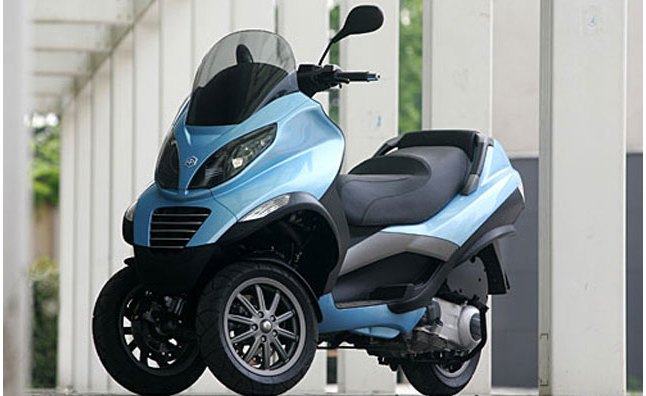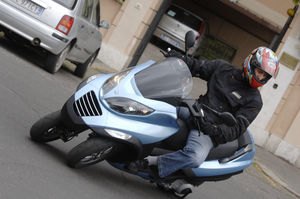Church Of MO – Two Wheels Good, Three Wheels Better?

I remember riding the Piaggio MP3 when it was introduced in America. A scooter lover at heart, underneath my sportbike-loving exterior, I wasn’t sure what to make of the MP3 and its three wheels. My opinion of it was solidified when I leaned the scooter/trike over through a turn and felt the outside front tire skipping. What would have likely resulted in a lowside on a two-wheeler ended up being a case of massive understeer, without ever separating myself from the scoot in a crash. From that point on I’ve always had a soft spot for all the Piaggio MP3 variants. In this week’s Church feature, Yossef Schvetz takes a spin on the MP3 at its European intro. His opinion? Awfully similar to mine.
Two Wheels Good, Three Wheels Better?
Photos by Piaggio
Hmmm… Are you skeptical about this three-wheeled thing? Well, here’s a nice anecdote that may shed some light as to what Piaggio was thinking when they built this odd-looking conveyance.
I am the only motorcycle rider in the office I work at. When I arrive at the office in a half-frozen state in winter time, I get my share of ribbing, but then when co-workers decide to meet downtown for a drink, I rib them back for being half an hour late. They’ve got to park their sardine cans somewhere, you know. It’s mostly a peaceful cohabitation. Nobody bugs me with the “bikes are dangerous” stuff; nor do I try to convince anybody to cross the line into two wheel-dom.
Yet, when I showed the folks in the office the first pictures of the new Piaggio three-wheeled MP3 scooter, there were some unexpected reactions, like an “Oh! This is one I could live with!” from a fashion-victim female project manger with a taste for expensive shoes and an “I would buy that!” from a golf-playing designer who never goes anywhere without a car. “Why?” I ask them–it’s a scooter after all–“Well, it looks much safer; you can’t fall off with three wheels, can you?”
So forget for a moment about the technology behind it, and whether it works or not. If a few pictures and a short video clip can do this to the plebes then you can rightly say that Piaggio hit the nail on the head, regardless of what we “true” motorcyclists might think of the three-wheeled creature. If people you wouldn’t suspect to be latent riders react so, then the potential of this thing to attract new blood to the two-wheeled word is very high.
Wait. Did I say two-wheeled world? Well, here’s the catch; this three-wheeler thinks it’s got only two most of the time. This is confusing. Is riding a three-wheeler that leans like it’s got two a betrayal of our holy two-wheeled beliefs?
In theory, three points of support will always give more stability. However, God IS in the details, meaning that there is more than one way to cook this three-legged turkey. When three-wheeled ATV’s stormed the American off-road market back in the Eighties they turned out to be a major liability headache to the Big Four with million-dollar lawsuits from parents of paralyzed kids. Those things overturned way too easily. Soon enough people understood that you either build something that leans into turns or you build a four-wheeler, hence the quad-wheeled ATV. Next!
Years later Honda built a funky scoot called the GiroX. For the first time a major manufacturer built a three-wheeler with leaning capacity, though the arrangement was rather primitive. A 50cc engine in a box powered two small rear wheels and was connected to the scooter-like front end through a basic swiveling joint so the rear wheels always stayed perpendicular to the ground. They proved to be good Pizza delivery tools, thanks to the huge box that could be attached to the rear end, but didn’t offer much improvement over traditional scoots otherwise. Next!
It seems like somebody understood at last that if there’s an advantage to three wheels, then it’s in having two of them on the front end. Italjet, a small scooter manufacturer from Bologna, presented such a prototype in 2001. The Scoop, as it was called, never went into production, but it showed a potential to improve on braking and front end stability. Italjet didn’t quite have the resources to develop the Scoop, but it turns out that people took notice.
Indeed, about a year ago, first reports about a strange contraption being spotted while attacking the hills around Piaggio’s Pontedera factory started to appear. A fewpaparazzi caught a rather Frankensteinian looking device with two wheels on the front. Soon enough, Piaggio revealed the first rough–but working–prototypes. At Bologna’s Motorshow, two 500 cc three-wheelers showed impressive leaning manners to the crowd, yet nobody seemed to understand how the thing really worked.
A few more months pass by, it’s Vespa’s 60th birthday and I find myself in Rome attending the MP3’s launch. The scooter looks production ready and a friendly Piaggio mechanic explains the riding drill to me. “See, this lever in the middle is the parking brake, pull it up and both the brakes and the leaning mechanism lock up for parking” What about this strange switch next to the throttle? “Well that’s the on-the-fly lock. If you are approaching a stoplight and don’t wish to put your feet down, just press it and only the leaning mechanism will lock, keeping you upright. Roll the throttle back on and it’ll disengage automatically. You don’t have to use it, though. Just ride it as if it was a normal scooter.”
Well, funky front-end aside, the MP3 sure looks like a normal mid-size scooter. I pick myself a 250 MP3 (there’s a 125-cc version too), turn the switch on, push the start button, release the handbrake and then simply twist ‘n’ go. Within five yards I pull my feet up onto the footboards without thinking twice with no strange zigzagging about. Before venturing out into the busy streets of Rome I allow myself some time to do figure-eights in the parking lot, but everything feels normal so far.
We set off with my photographer in tow on another MP3. After less than 50 yards we come upon a big junction, take a sweeping left turn at a nice 40-45 MPH pace and all I can think is: mmm… this thing turns really nice. At this point I spot the photographer who’s following me in my mirrors. He must be doing the same speed as I am but he’s leaned waaaaay over, as if he’s chasing Rossi at Mugello. I guess that I must have been leaning just as hard, but I wouldn’t have guessed.
A few more turns and it becomes clear. This system supplies such a reassuring feeling and response from the front end that way-out lean angles are alarmingly easy to achieve. It’s surreal. We choose an empty roundabout to shoot photos, I make some passes in front of the camera and then stop to check out the digital results. You mean to tell me that I was leaning that far? I am still shocked.
It’s not only the MP3’s propensity for high lean angles that impresses. On this very roundabout there are plenty of bumps, the road surface is far from clean and there are some white-painted pedestrian crossing stripes, but the MP3’s front end takes it all with aplomb. It’s as if the two wheels help each other to find grip rather than fight between them for it.
By now I have a strange enlightenment. Throughout my 28 years of riding I’ve always been watching where I put my front wheel. With two in the front, all of the sudden this becomes much less of an issue, if not a downright non-issue. Even if one wheel hits a bad patch, there is always the other one to provide proper grip. On my way back to the parking lot, I try and hit some bumps and holes “asymmetrically” with just one wheel and the front suspension seems to be head and shoulders above what I experienced in other scooters or even on some motorcycles. If anything, this brings to light the limitations of the rear end as it has to deal with the usual (for a scooter) swingarm/engine unit, i.e. a lot of unsprung weight.
It’s time for a good Roman espresso break, and to think about how this whole thing works. At the end of the video clip found on the Piaggio website there’s a good animation that explains the complex kinematics better than a thousand words. Basically it’s a four-joint parallelogram that supplies a freedom of movement not unlike that of the legs of a downhill skier.
While leaning, the inside wheel goes high up while the outer wheel gets pushed down. The joints have bearings and there’s no spring force trying to straighten the plot up. Only the normal stabilizing forces of rake and trail work here. Each side of this quadrilateral mechanism has a separate steering stem that allows the wheels to swivel, the commands from handlebar arriving via push-pull rods much like those found in a go-kart or a quad.
On top of that, each wheel is equipped with its own leading-link suspension arm, (the articulated arms of the leaning mechanism do not act as a suspension) and each front wheel has also its own disk brake. Wake up; we’re not finished yet. In order to lock the leaning mechanism for parking there’s a funny-looking caliper that bites a half-moon disk but since the suspension arms need to be locked too, there are also twin hydraulic calipers that grip two long sliding struts. It sounds complex and it really is.
There are plenty of hydraulic parts and wheel speed sensors as well as bearings, cast arms and who knows what else below the skirt covering the front end. With such a vast display of hardware hiding in there, nobody should be surprised that the MP3’s weight is a good 40 lbs. more than that of a typical 250 city scooter.
In terms of styling and other features the MP3 gets aligned with mid-range 250cc scooters such as the Honda Reflex. There is a sizable sofa-like saddle and plenty of storage space under the seat with a mini trunk door allowing access from the rear without lifting the seat. The compartment is big enough for two open face helmets or a laptop bag. There’s a typical leg shield on the front, which includes a small windshield. All in all it’s quite standard.
looking and in a way, not quite in harmony with the technical innovation beneath the body panels. It seems like the Piaggio management deliberately instructed their designers to keep it calm, and from the front, the MP3 looks more like a shrunken SMART mini car. That’s a bit of a shame, in my humble opinion.
The latest water-cooled 250 single four-stroke power unit powers the plot. It’s the same unit installed in the latest version of the Vespa GTS250 and it delivers 22 hp. Power is passed on to the rear wheel through a belt drive / stepless variator transmission.
It’s back to the road then. For my second stint I join a few other throttle-happy journalists and our Roman mayhem festival starts in earnest. Even the tough Roman scooter riders couldn’t remain indifferent when our MP3 squadron attacked corners at full lean in tight formation. Japanese tourists trying to cross the street in front of us simply ran away in panic and horror.
While playing those kinds of antics, the MP3 brakes were tested to the fullest. Piaggio claims 36.57% improvement in braking (or something like it); I don’t know about that. What I do know is that the twin wheels and twin disks on the front let you brake hard, like a proverbial horse, without much worry about the front locking or the rear lifting up (it happened only once). Is that scientific enough? More to the point, the fact that there are two wheels out front keeps the MP3 extremely stable under braking. On the downside, with so much weight over the front, the rear was way too easy to lock.
Talking about the poor rear end, the amazing grip available from the twin wheels brought to light the limitations of the simple rear suspension pretty early. Over the many cobblestone streets of Rome, it was easy to make the rear step out by giving some throttle. If anything, it showed how easy it was to tame the drifting rear wheel with light countersteering. We continued to play in this huge playground and also discovered the ease with which the MP3’s front will climb over traffic islands, especially if you hit the curb at an angle. It’s as if the shock gets divided by two and there’s hardly a jolt from the front end.
At the end of the day we were scraping the exhaust pipe on the right, the center stand on the left and this brings to mind my anecdote. One motojournalist did take this too far and crashed; there’s still a limit to tire grip. Even without that happening, it’s pretty obvious that the MP3 is no car. Run an MP3 into a wall and you’ll be hurt just as if you were crashing a VFR. The extra cornering and braking capability add to the dynamic safety but to call the MP3 a “safety scooter” will be misleading. Beginners are warned.
I have a soft spot for scooters. I even own a PX200 that I always use when I visit mom, but I am not day-dreaming about retrofitting this new system to my trusty Vespa. This innovative front end left me thinking this more than anything: What if? Yes, what if it was installed in a proper sport bike with uprated everything, of course, like sticky tires and proper shocks? If this system has turned a humble scooter into a mean lean machine, you can only wonder what it could do to a proper mount. Just imagine the deep braking that two contact patches in the front could let you get away with.
Even in its first incarnation, this system is way more clever and advanced than the Tesi center hub or any of BMW’s funky fronts. It also dares to ask: Who said bikes must have only two wheels in the first place? I, for one, live for leaning: the more the better, and if three wheels will let me get away with more, who am I to care how many wheels it has?
So our hats are off to Piaggio for their out-of-the-box thinking and for developing such a ground-breaking, well-functioning idea. Don’t be surprised if it’s the beginning of a serious revolution that’ll reach very far. The next step? A sporty 500cc, 40 hp three-wheel tool is in the works. The photographer and I can’t wait to try that one.

Troy's been riding motorcycles and writing about them since 2006, getting his start at Rider Magazine. From there, he moved to Sport Rider Magazine before finally landing at Motorcycle.com in 2011. A lifelong gearhead who didn't fully immerse himself in motorcycles until his teenage years, Troy's interests have always been in technology, performance, and going fast. Naturally, racing was the perfect avenue to combine all three. Troy has been racing nearly as long as he's been riding and has competed at the AMA national level. He's also won multiple club races throughout the country, culminating in a Utah Sport Bike Association championship in 2011. He has been invited as a guest instructor for the Yamaha Champions Riding School, and when he's not out riding, he's either wrenching on bikes or watching MotoGP.
More by Troy Siahaan















































Comments
Join the conversation
Kawasaki J Concept :)
LOL at my captions I wrote 10 years ago.